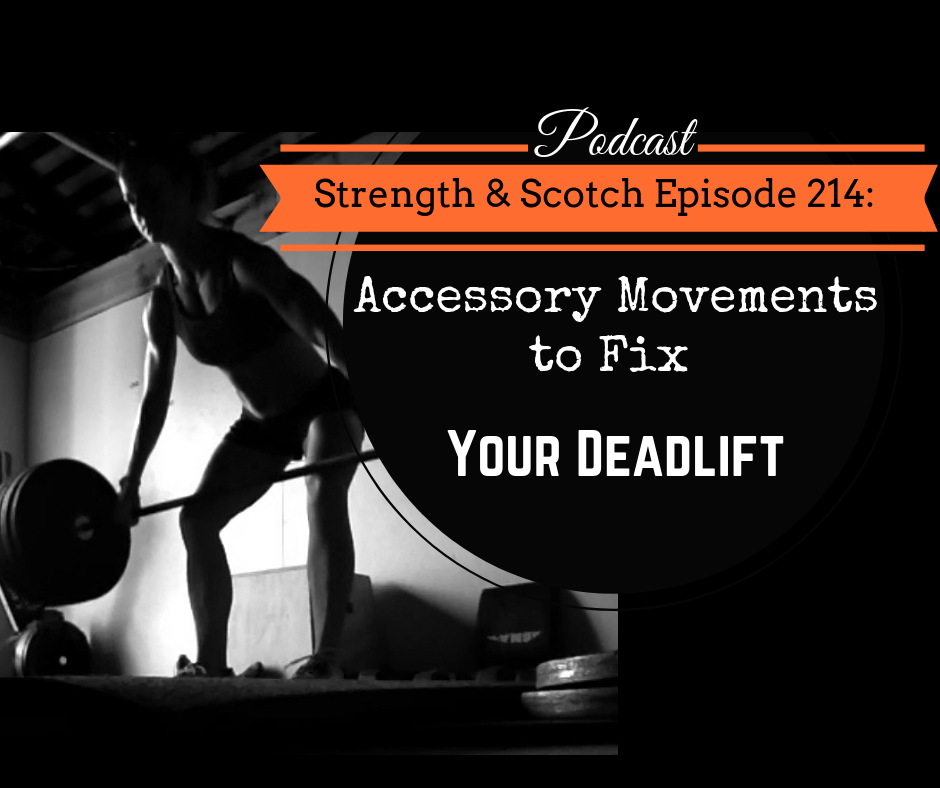SS 214 – Accessory Movements to Fix Your Deadlift
Episode 214 Show Notes
In this week’s episode Coach Heavey shares his favorite accessory movements to improve your deadlift. Whether your sticking point is pulling off the ground, lockout or somewhere in between, we’ve got you covered with Heavey’s favorite accessory exercises to help bust thru that plateau.
[00:56] Two Areas of Weaknesses
In the deadlift, there are two places in the movement where most lifters will fail as the weight gets heavy. One is in the mid-range where you get the barbell up, just above or just below the knees. The other is struggling to get the bar up off the ground.
[01:15] The Mid-Range Weakness
Difficulties at and around the knees when the weight gets heavy is often due to a lack of hamstring or lat strength. There are various movements to address this.
First, is the Romanian Deadlift (RDL). This is one of the best movements out there for building transferrable strength for the deadlift. One of the key points of performance in RDL is to maintain soft knees and hinge at the hips. A lot of lifters won’t think their knees are bending. Try to take a video of yourself from the side to see if they bend as you lower the bar down. This could be due to the flexibility of the hamstrings. Do your best to keep your shins perpendicular to the ground. As you’re lowering the bar, remember to always push your hips back.
Another great movement for a weakness in the mid-range of the deadlift is the pause deadlift. If you want to get stronger in a certain position, it’s helpful to spend more time in that position. If you pause for a couple of seconds in the position just below your problem spot where you’re experiencing your failures during the movement, it’s super powerful.
Now, you want to stop just below the sticking point because that’s the point where you’re starting to feel a deceleration in the bar. Additionally, make sure that the pause is a full pause – meaning count for two. Move on and accelerate out of the position.
[03:15] Touch-and-Go Deadlifts
This movement carries a lot of baggage. For the right lifter and for this particular problem, these can be very helpful. The momentum you gain as the plates bounce off the floor helps you overload the movement beyond what you normally would be able to do. As a result, you get to develop further hamstring strength. Make sure your deadlift form is on point first; otherwise, this may not be a great movement for you.
[04:06] The Bent-Over Rows
You don’t immediately think of lats and upper body work when you think about trouble with the deadlift. But your lats help you keep the bar close to your body during the movement.
Bent-over rows are most helpful for improving relevant lat strength in helping you get through being stuck.
Again, RDLs, pause deadlifts, touch-and-go deadlifts, bent-over rows — all of those can help with that mid-range weakness in the deadlift, when you’re failing the movement or when it gets heavy at just above or below the knees.
[05:00] Free the Grip!
You can use lifting straps for any of these movements. What you want to do here is overload the movement or get more time in the problem areas than to focus on grip strength. Straps can help us take grip out of the equation and focus on our larger musculature when we’re struggling in the mid-range of the deadlift.
[05:22] Get It Off the Ground!
The other common deadlift problem area is getting the weight up off the ground. This is when the weight gets heavy and you fail to even get the bar just a couple inches off the ground. Most of the problems are due to improper breathing and bracing as well as lack of strength in the quads and the lats. Back in Episode 203, Kabuki Strength dove deep on breathing and bracing and the things you can do to improve that, and ultimately, improve your strength and the deadlift — all your lifts, really. In fact, this stuff is often overlooked by lifters.
[06:22] The Deficit Deadlift
The most common accessory movement used for building strength up off the ground is the deficit deadlift. This is where you stand a couple of inches off the ground, stand on a plate, and from standing on that elevated platform, you do a normal deadlift.
The biggest fault in most lifters doing this movement is to make the deficit too great. Setting yourself up four inches off the ground doesn’t make it better than 2-3 inches off the ground. The higher you go, the more it alters the movement pattern and reduces the transferability into your regular deadlifts.
For most lifters, Heavey recommends a deficit of somewhere between 1-2 inches for the deficit deadlift.
[07:30] The Pause Deadlift and Quad Dominant Lifts
Weakness off the ground can be improved with pause deadlifts but by pausing in different spots, specifically stopping about one inch off the ground. Pick the weight up about an inch off the ground then accelerate up into the full range of the movement and set the weight back down.
Quad dominant lifts could be anything from quad machines to maybe using safety bar squats or front squats. This will help build that leg drive that will benefit you during your initial pull. If you have a trap bar around, do weighted jumps with it. Work on that explosiveness off the ground because it has a high transferability to deadlift strength. If you don’t have that trap bar, use kettlebell or dumbbells.
[08:40] The Pendlay Row
This is another upper body movement and lat strength that a lot of people don’t think about when they think about building their deadlift strength. But this is very effective in helping with your barbell positioning during that initial part of the deadlift. Make sure to maintain tension in your lats during the full range of motion.
[09:11] A Quick Recap
The movements you can add to your accessory program to help with weakness and deadlift off the ground are deficit deadlifts, pause deadlifts, quad-focused movements, weighted jumps, and pendlay rows.
For any of these movements, do a few sets a couple of times a week for about 8-10 reps. These will absolutely help you with those specific weaknesses.

Check out the gear page for everything Strength & Scotch! You’ll find a listing of all the supplements and other programs we’ve discussed on the show as well as our killer t-shirts!

